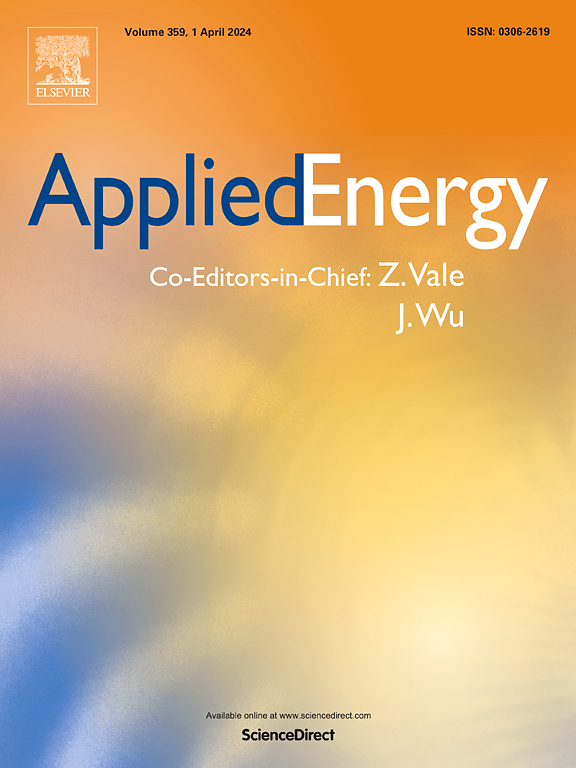基于模型预测控制的比特币挖矿集成温室能量优化
IF 11
1区 工程技术
Q1 ENERGY & FUELS
引用次数: 0
摘要
本研究提出了一种新的控制框架,将比特币采矿废热与温室气候调节相结合,利用模型预测控制来提高能源效率和经济可行性。虽然已经通过热建模和参数化研究探索了利用比特币采矿余热进行温室加热的可行性,但这项工作的重点是实时预测控制,根据外部天气条件和作物需求动态调节温度、湿度和二氧化碳浓度。MPC框架通过利用实时天气数据和预测模型来管理温室的动态和相互关联的气候条件。通过动态控制执行器,如风扇、百叶窗、加热系统和二氧化碳注入,该框架确保作物生长的最佳条件,同时最大限度地降低能源成本。在代表不同气候带的8个城市中,对不同规模的温室(个体、半商业和商业)进行了模拟。结果表明,MPC通过减少高达15%的能源消耗,同时在95%的时间内将气候条件保持在目标范围内,从而优于开关控制。此外,经济分析表明,整合比特币采矿废热带来了显着的盈利能力,在高比特币价格下,商业规模的温室的年净利润高达150万美元。研究结果建立了一种可扩展的智能控制策略,将比特币挖矿与农业结合起来,促进可持续粮食生产,同时优化能源使用,减少农业经营中的温室气体排放。本文章由计算机程序翻译,如有差异,请以英文原文为准。
Energy optimization of bitcoin mining integrated greenhouse with model predictive control
This study presents a novel control framework that integrates bitcoin mining waste heat with greenhouse climate regulation, leveraging model predictive control to enhance energy efficiency and economic viability. While the feasibility of using bitcoin mining waste heat for greenhouse heating through thermal modeling and parametric studies has been explored, this work focuses on real-time predictive control, dynamically regulating temperature, humidity, and CO2 concentration based on external weather conditions and crop requirements. The MPC framework manages the dynamic and interconnected climate conditions of the greenhouse by leveraging real-time weather data and predictive models. By dynamically controlling actuators such as fans, blinds, heating systems, and CO2 injection, the framework ensures optimal conditions for crop growth while minimizing energy costs. Simulations are conducted for greenhouses of varying sizes (individual, semi-commercial, and commercial) across eight cities representing diverse climate zones. Results show that MPC outperforms On-Off control by reducing energy consumption by up to 15 %, while maintaining climate conditions within target ranges over 95 % of the time. Furthermore, economic analysis demonstrates that integrating bitcoin mining waste heat results in significant profitability, with net annual profits reaching up to $1.5 million for commercial-scale greenhouses under high bitcoin prices. The findings establish a scalable and intelligent control strategy for integrating bitcoin mining with agriculture, advancing sustainable food production while optimizing energy use and reducing greenhouse gas emissions in agricultural operations.
求助全文
通过发布文献求助,成功后即可免费获取论文全文。
去求助
来源期刊

Applied Energy
工程技术-工程:化工
CiteScore
21.20
自引率
10.70%
发文量
1830
审稿时长
41 days
期刊介绍:
Applied Energy serves as a platform for sharing innovations, research, development, and demonstrations in energy conversion, conservation, and sustainable energy systems. The journal covers topics such as optimal energy resource use, environmental pollutant mitigation, and energy process analysis. It welcomes original papers, review articles, technical notes, and letters to the editor. Authors are encouraged to submit manuscripts that bridge the gap between research, development, and implementation. The journal addresses a wide spectrum of topics, including fossil and renewable energy technologies, energy economics, and environmental impacts. Applied Energy also explores modeling and forecasting, conservation strategies, and the social and economic implications of energy policies, including climate change mitigation. It is complemented by the open-access journal Advances in Applied Energy.
 求助内容:
求助内容: 应助结果提醒方式:
应助结果提醒方式:


